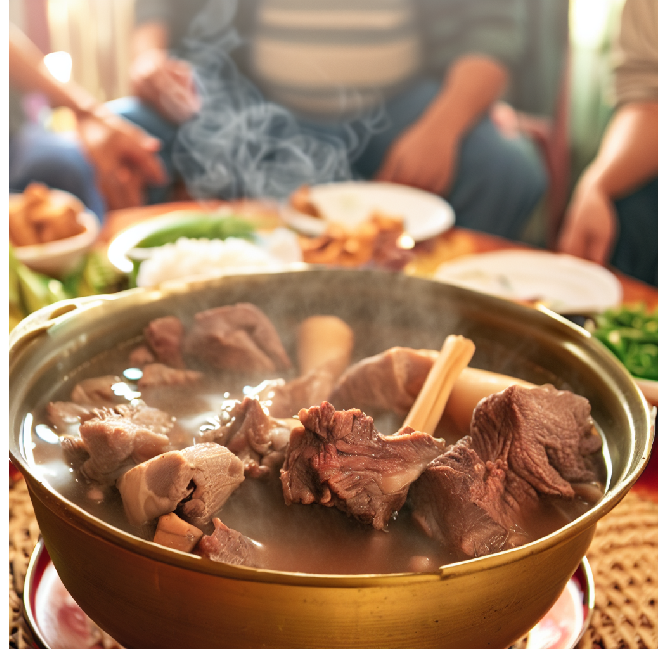The Origins and Variations of Filipino Bulalo
Bulalo is a traditional Filipino soup beloved for its simple yet full flavor. It features a rich beef broth, tender beef shanks, and the marrow inside the bone, which is a delicacy. It is often enjoyed during cold weather, particularly in the provinces of Batangas and Cavite. The dish represents the deep connection between Filipino cuisine and its historical, agricultural, and regional contexts.
Bulalo’s origin is closely linked to the cattle farming regions in southern Luzon, particularly in Batangas and Cavite. These provinces are known for their beef production, making beef shanks (often referred to as "bulalo" in the vernacular) easily accessible and affordable. The simplicity of the dish likely arose from the rural communities’ need for a meal that maximizes flavor with minimal ingredients.
Traditionally, bulalo is slow-cooked over a wood fire, which enhances the natural flavor of the beef. The marrow within the shank bones is a particular delicacy, and the long cooking time allows it to soften, releasing rich, fatty flavors into the soup. Historically, the dish reflects Filipino hospitality—bulalo is often served during gatherings, symbolizing warmth and sharing.
Bulalo is more than just a dish; it is a cultural experience. For many Filipinos, particularly in the countryside, bulalo represents comfort food. It is frequently enjoyed in eateries called "bulalohans," especially in the city of Tagaytay, where cooler climates make the hot broth even more appealing.
In Tagaytay, with its view of Taal Volcano, eating bulalo has become almost a ritual for visitors. The dish's connection to family and community meals is integral to Filipino culture, as food is central to social bonding. Sharing bulalo, whether at home or in roadside stalls, emphasizes the communal aspect of Filipino dining.
Regional Variations of Bulalo
Though the essence of bulalo remains the same, different regions across the Philippines have added their unique twists to the dish.
1. Batangas Bulalo
Batangas, known as the "home of bulalo," serves the most traditional version of the dish. The broth is rich and clear, focusing on the natural flavor of the beef shanks. It typically includes vegetables like cabbage, corn on the cob, and potatoes. Some versions also add green beans or pechay (Filipino bok choy). The broth in Batangas is not overly spiced, allowing the taste of beef and marrow to shine.
2. Tagaytay Bulalo
In nearby Tagaytay, where bulalo is almost a staple for tourists, the dish often includes a more flavorful broth, achieved by simmering the meat for hours to extract the marrow's richness. Tagaytay's version is often more robust, and some restaurants add their flair by using a combination of various vegetables, such as carrots, and seasoning the broth with additional herbs.
3. Cebuano Pochero
In the Visayas, particularly Cebu, a variant of bulalo known as "pochero" exists. This version has Spanish influences and includes more diverse ingredients such as bananas (particularly the saba variety), sweet potatoes, and even chorizo, giving it a slightly sweeter and more complex flavor profile. The dish is still centered around beef shanks and marrow but is heartier, with a more diverse range of flavors.
4. Bulalo sa Buko (Bulalo with Coconut)
In some parts of Mindanao, particularly in areas where coconuts are abundant, there’s a variation known as "bulalo sa buko." This version adds a twist by using young coconut juice in the broth, which provides a subtle sweetness. The coconut meat is often served with the soup, giving it a unique texture and added flavor dimension. This variant highlights the influence of local agricultural products on traditional dishes.
5. Bulalo with Bone Marrow Sinigang
In certain areas of Metro Manila and Southern Luzon, you’ll find a fusion of bulalo and the classic Filipino sour soup, sinigang. Here, tamarind or other souring agents are used to give the broth a tangy flavor, balancing the richness of the bone marrow. This variation combines the best of both worlds: the richness of bulalo and the refreshing sourness of sinigang.
Bulalo's history and regional variations reflect the diversity and richness of Filipino culture. Whether it's the traditional Batangas version or a modern twist found in a fusion restaurant, bulalo remains a deeply cherished dish in the Philippines. It continues to be a staple in Filipino culinary tradition, bringing warmth and comfort to those who enjoy its rich broth and tender beef.



























It all started with a table outside of a Seafood City in 2015.
LEAD Filipino volunteers were on hand with clipboards and flyers for a Filipino voter registration drive. It was an early campaign for the grassroots organization, which grew out of a desire to build Filipino civic voice and representation.
Read More